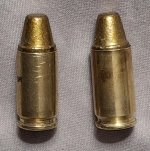That's what I want to know....
...before getting to the range. The best test I have is plunking in a barrel. When I plunk factory ammo, it plunks solid and 99.99% of the time, works fine in any gun. I'd like to know why my reloaded ammo either plunks well, or is 'mushy' and DOESN'T work flawlessly 100% of the time. I'm not obsessing about plunking. My percentage of good 9mm ammo has gone way up because I've been dogging at it for years. But these inconsistancies seem to point to something I'm still not getting right when loading for semi auto pistol.
There's a BIG difference between plunking solid and being mushy enough to stick in the chamber when pressed in and needing a screwdriver to extract it.
I've gotten a lot of good leads here. Thanks to everybody.
Oh, BTW: One problem I have is that range brass varies a LOT, some I think are .380 brass but when I look at it it's clearly stamped '9mm Luger'.
"Plunk" or close to it is fine, but it's not necessary that they "plunk". What's more important than "plunk" is that they feed and chamber flawlessly 100% of the time.
...before getting to the range. The best test I have is plunking in a barrel. When I plunk factory ammo, it plunks solid and 99.99% of the time, works fine in any gun. I'd like to know why my reloaded ammo either plunks well, or is 'mushy' and DOESN'T work flawlessly 100% of the time. I'm not obsessing about plunking. My percentage of good 9mm ammo has gone way up because I've been dogging at it for years. But these inconsistancies seem to point to something I'm still not getting right when loading for semi auto pistol.
There's a BIG difference between plunking solid and being mushy enough to stick in the chamber when pressed in and needing a screwdriver to extract it.
I've gotten a lot of good leads here. Thanks to everybody.
Oh, BTW: One problem I have is that range brass varies a LOT, some I think are .380 brass but when I look at it it's clearly stamped '9mm Luger'.
Last edited:

